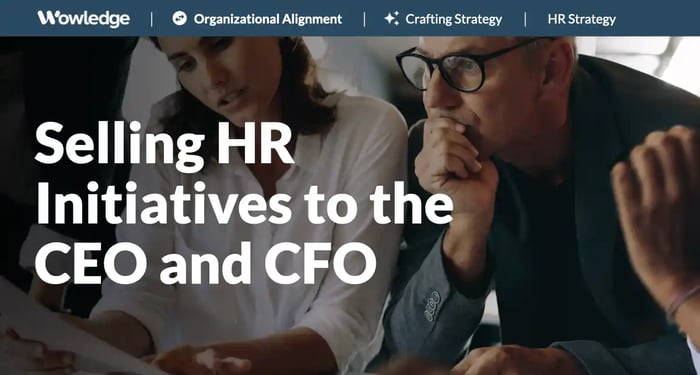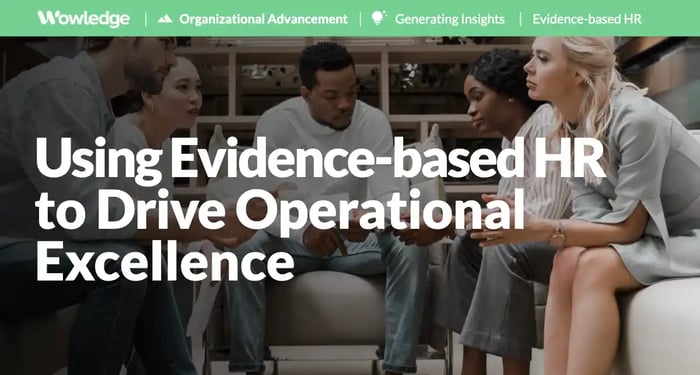We often hear the narrative among HR professionals. The CEO and CFO may not always listen to HR, despite our keen understanding of the company's issues and our innovative ideas for improving talent management. Even as CHROs and heads of HR are securing seats at the proverbial “table,” there are still grumblings about the respect and attention paid to what HR brings to this table. It's crucial to recognize HR professionals' pivotal role in talent management and ensure their voices are heard. Understanding how to sell HR initiatives is critical for CHROs and their teams.
It's a common misconception that CEOs and CFOs don't prioritize talent issues as much as other C-Suite leaders. Surveys consistently show that talent issues are among the top concerns for CEOs in the US and globally. The Conference Board has even stated that attracting and retaining talent is the top internal priority for all CEOs, and labor shortage concerns are among the top 10 external priorities. Price Waterhouse Coopers (PWC) found that talent is a top five priority for CFOs. This quote encapsulates it perfectly – “successful finance transformations start with people.”
We understand that talent is a priority and talent issues are real. However, why does HR talent still feel undervalued and without a voice? The answer lies in our narrative or how it is presented to our stakeholders. Too often, we present ideas that are not rooted in their problems. We are not speaking the language of our CEO and CFOs. This article will delve into how you can capture the attention of your CEO and CFO and how to sell Human Resources initiatives by piquing their interest in your ideas to build more influence and impact in your crucial role in talent management. It's time to ensure your voice is heard and your ideas are recognized for their potential to impact business and talent outcomes significantly.
Get the CEO and CFO’s attention!
As with any presentation, you must consider what will grab the attention and influence action to sell HR initiatives and solutions. Forbes released an article that defined the three steps a person should go through to gain influence in presentations and discussions. These three steps are:
1) Analyze your audience.
2) Understand the reaction you seek to elicit.
3) Modify your delivery.
Understanding these three main steps towards influence, let’s apply them to our CEOs and CFOs. What will grab their attention and influence them to listen to HR’s ideas and initiatives? Let’s walk through each one, starting with the crucial step of understanding your audience.
Analyze your audience
This is interesting because, as a member of your organization, you probably already have a good understanding of the people you are trying to influence. You understand their demographics and probably have some insight into their general working styles and relationships. However, we can sometimes underestimate the power of a deeper understanding of the executive mindset and constant situational analysis to best sell HR initiatives.
Understanding the executive mindset often evokes the image of an impatient executive who focuses on the bottom-line numbers. When we think of what a CEO is juggling in the role, we know that it is not just bottom lines but rather a focus on building synergies, cultivating and retaining talent to get the work done, and risk mitigation, to name a few. McKinsey did a great job in an article outlining all the elements and mindsets that a successful CEO needs.
Knowing that your CEO is analyzing all these areas and trying to make all these connections is essential to understanding how to frame your idea or project in a way they care about. The CFOs have the same concerns, especially regarding value creation.
Think about how this changes an HR idea frame. If we have a turnover issue in a business unit, HR may come to the CEO and CFO with an idea for developing and improving leaders' and managers' people skills. The idea may be the solution, but framing the issue this way will not grab the CEO or CFO’s attention. They do not necessarily care about training managers as a solution for turnover. It needs to be linked to their frame of mind. In this case, the turnover could be directly connected to lagging business results in that function or could create a brand reputation issue. Alternatively, it could be a process or organizational design issue we are solving. Turnover, in and of itself, does not necessarily mean action needs to be taken. Lagging business results, customer retention issues, and more will be the issues the CEO and CFO will latch onto in the discussion.
Conducting a situational analysis is the other part of understanding the audience for influence. What are the most pressing issues right now? Connecting the idea to the pressing issues is critical to sell HR initiatives. Also, can you identify the political and organizational dynamics of the organization? Does the CFO (or another C-Suite member) have a lot of influence on the CEO in decision-making? If so, get that person onboard beforehand with the idea. Are we facing budget restraints right now? If so, discussing return on investment (ROI) and value creation is even more critical now.
Beyond just the dynamics of the organizational environment, try to get a sense of what is coming before and after this discussion. Do you know the Chief Revenue Officer is proposing a new sales initiative? If so, is there a way to build synergy between your ideas or connect them to what you want to do in Human Resources?
In your situation analysis, you should also consider how this request will support business initiatives fluidly and without additional distraction if possible. The Harvard Business Review's article “Why HR Still Isn’t a Strategic Partner” discusses how HR needs to create flow instead of friction. “Of every action you take as an HR leader, ask this simple question: does it cause friction in the business, or does it create flow? Friction is anything that makes it more difficult for people in critical roles to win with the customer. Flow, on the other hand, is doing everything possible to remove barriers and promote better performance.” Does your message highlight that this project is a strategic, frictionless solution?
Framing your ideas in a way that caters to the executive mindset and with situational analysis will build the foundation for influence to help sell HR initiatives. Now, let’s discuss how you frame the reaction you seek.
Understand the reaction you seek
You are coming to the executives with something. It could be to deliver good news about an initiative and push for more support. It could be bad news driving the proposal that you will be making. It could be somewhere in between. In either case, you must be abundantly clear on what you want them to do after hearing your presentation.
State the request clearly. There have been times when, as an executive, I would have team members come to me with a proposal. The proposal would be framed as a summary of the situation and then a lot of information about things that can be done to solve the problem. I often had to interpret the main request for the presentation. Don’t make your executives guess. Be concise in what is being requested of them and use action words to clearly articulate the following steps and, more importantly, the requests to the executive. State what you want early and use the remainder of the time to discuss the rationale and ROI behind it. Clarity helps sell HR initiatives.
Prepare and present with confidence. In addition to being action-oriented in our request, we must also exude confidence in our ideas and proposals. One article talks about how confidence is just as important as expertise, if not more, for leaders. “Confidence can be built up by acquiring knowledge and skill, but that sort of confidence can be shaken when someone who knows more or has more skill shows up. The confidence to step into novel situations, listen, learn, and make good decisions is as valuable as expertise.” When we talk about leaders, it is not just what you know but how you can utilize this expertise and guide the organization. HR leaders should be well-versed in these skills because we work in dynamic daily situations. However, there is usually a lack of confidence in our business knowledge, which causes us to defer or be less confident when challenged by CEOs and CFOs. Take the time in your situational analysis to understand the business context, and then go into the discussion, knowing that you may not be the expert but are well versed in the topic. And more importantly, you are confident in your idea, so let that confidence shine through.
Once we know how to elicit reactions to our ideas, we must consider how to deliver them for influence.
Modify your delivery
Align your emotions. Ensuring that your delivery will keep executives' attention is crucial for influence. While we do not expect HR professionals to be professional actors, the message's words and delivery must be congruent. If you are excited about the idea, show it. If you are concerned, make sure that your tonality expresses concern. When discussing ideas with senior executives, our nerves will preclude us from leaning into our real emotions. This disjointed message and delivery can lead to disengagement or trust issues with your targeted audience.
Engage a partner. In addition to how you present your idea, you should also consider leveraging a sponsor in the room beforehand. Perhaps you have a good relationship with the CFO or another C-level executive. Meet with this sponsor beforehand to ensure that your message is landing correctly, identify potential pitfalls or gaps, and then discuss what to be prepared to answer for in the discussion. In addition, by getting this person’s buy-in before the meeting, the other leader can also advocate for you in the meeting.
Plan your time wisely for impact. Only a third of your allocated time should be spent on the presentation. You want dialogue with your executives, so speaking to them the whole time will disengage them. Have it interactive, and make sure that you are not using the total time for a presentation and are leaving unanswered questions on the table. Use the presentation model of 1) stating the issue and your request upfront, 2) outlining why in a high-level overview, focusing on the business imperative, 3) discussing ROI and impact, and 4) restating the request.
The correct delivery methods will go a long way toward getting the CEO and CFO’s attention for important HR projects. If you take the time upfront to understand the mindset, create clarity on the actions you seek, and use the tools to deliver for influence, HR will get the executives' attention and more effectively sell HR initiatives.

Your checklist for success
As you prepare for your next project or idea pitch to your CEO and CFO, use this checklist to ensure you are well-positioned to get and influence their attention.
1. Problem-solve for a business issue
Does your presentation address a business issue first? CEOs and CFOs want to understand the business imperative being addressed in the proposed HR solution. Be upfront about the connection to the business issue, and do not make your audience guess how it will be part of a solution to address pressing organizational challenges frictionlessly.
2. Understand the mindset
Does your presentation consider the executive mindset? Have you ensured that your request is made upfront? Are you minimizing the minutiae, talking less, discussing more, and situationally aware of what else could be impacting the influence of your idea? Planning for the mindset will go a long way toward enabling you to frame a presentation for influence and more effectively sell HR initiatives.
3. Be clear on the “ask” and the ROI
Does your presentation expressly state your request for the CEO and CFO? Is it an approval to move forward? Is it a resource or funding approval? Is it vocalized support for an initiative? Be clear on the request from the beginning to the end of the presentation. And, as importantly, does your presentation address the return from this action? What will be solved by doing this, and how will it create value for the organization in financial terms?
4. Practice the pitch and build sponsorship
Have you built a relationship with a senior leader who can give honest feedback? Are they willing to tell you where the presentation will resonate, or not resonate, with the CEO and CFO? What is not clear, and what needs to be further supported? What questions or challenges should you expect? Get candid feedback upfront to strengthen the discussion and prepare for challenges. Have you asked for their support for the idea? Doing the background work to get buy-in from organizational influencers can go a long way to getting the ultimate decision you seek.
Next steps
HR brings value to the organization with its depth of expertise and employee data to cultivate and engage talent. What is needed to be more influential is a better business-oriented narrative. This executive-focused checklist will build a narrative that will get the attention of your CEO and CFO, not just to listen but also to influence action.
Relevant Practices & Tools
Core HR Strategy Practices to Define a Foundational Direction for the HR Function. >
An HR Strategy sets business-based human resource (HR) tactics that will constitute a comprehensive multi-year approach to managing the HR function's structure... more »
Assessing External and Internal Business Trends, Pressures, and Drivers of HR Strategy. >
An important step in the development of a comprehensive HR strategy is researching and determining factors that are currently (or projected to be) operating in an environment... more »
Assessing the Change Impact on Specified Stakeholder Groups for Prioritizing Activities. >
Understanding how an initiative will impact the organization and specific stakeholder groups or people is key to designing effective change management strategies... more »
Employing Advanced Stakeholder Engagement Techniques to Reinforce the Criticality of the Targeted Change. >
When done effectively, stakeholder engagement creates trust with the initiative team, generates honest dialogue to build support for the changes, and reduces the potential for conflict... more »
The Internal Environmental Scan Tool: Capture and Categorize Factors Internal to the Company Impacting its Objectives. >
This template provides a structure for identifying key internal topics that should be considered in a formal analysis of the business’s upcoming challenges... more »
About Wowledge
Wowledge is the expert-driven platform for lean teams building strategic HR programs. Members enjoy access to up-to-date best practices, step-by-step guides, tools, templates, and insights to accelerate the design and implementation of all key HR programs and processes.
Since each organization has unique characteristics, needs, and aspirations, Wowledge's practices are developed utilizing an exclusive stage-based approach – from Core to Advanced to Emerging – that reflects distinct levels of sophistication to meet our members where they are.
Build strategic HR programs with refreshingly easy-to-follow best practices.
Get started for FREE! Learn more.











